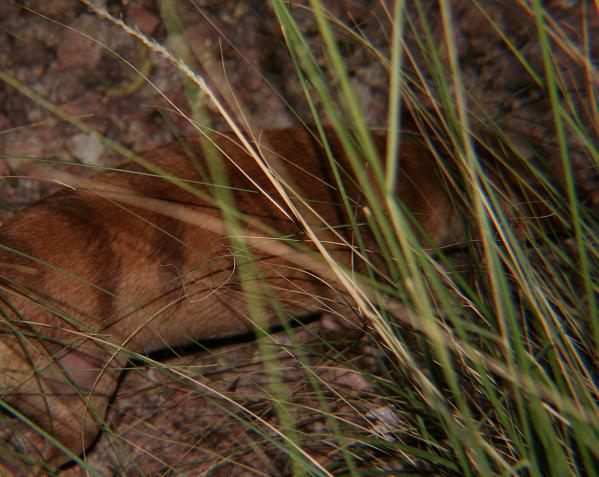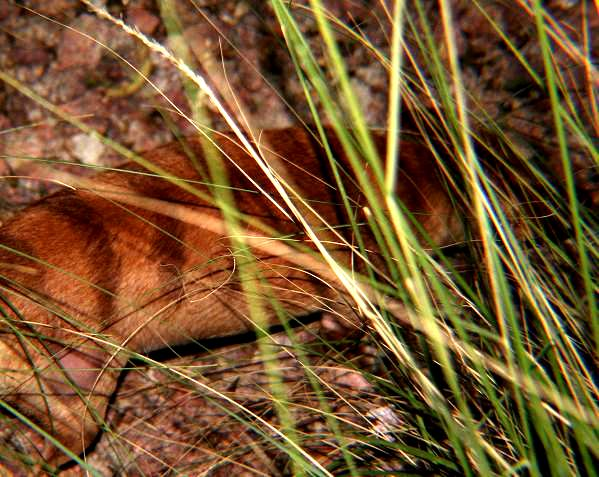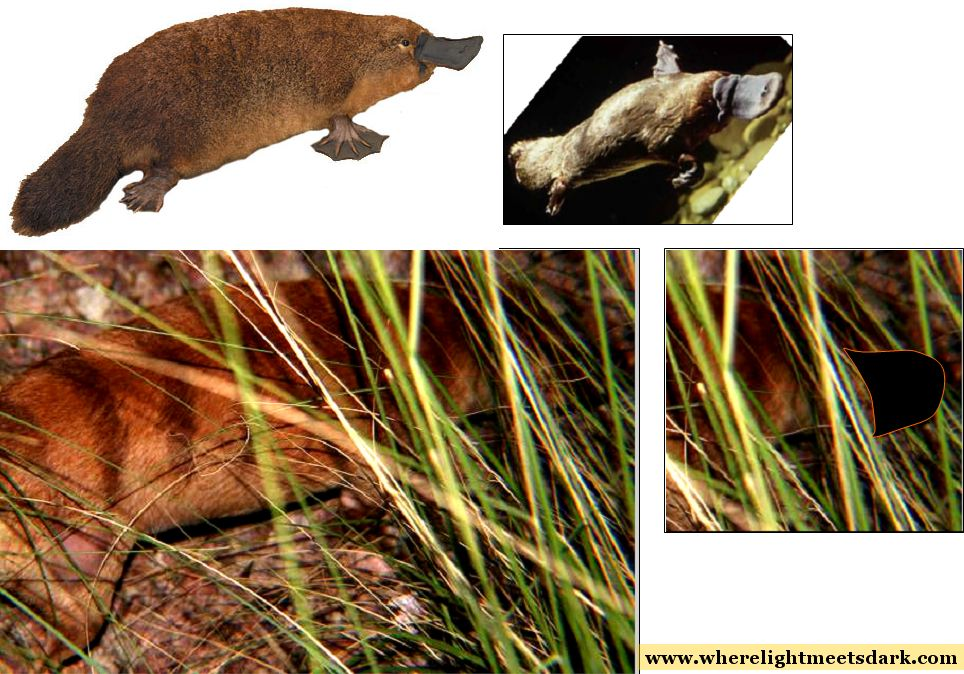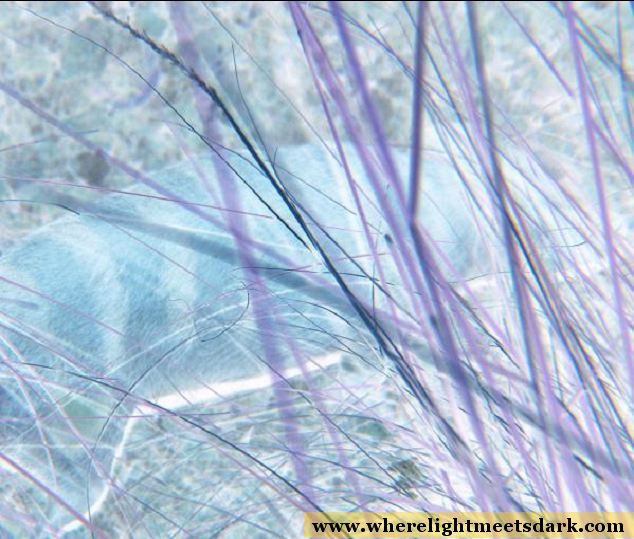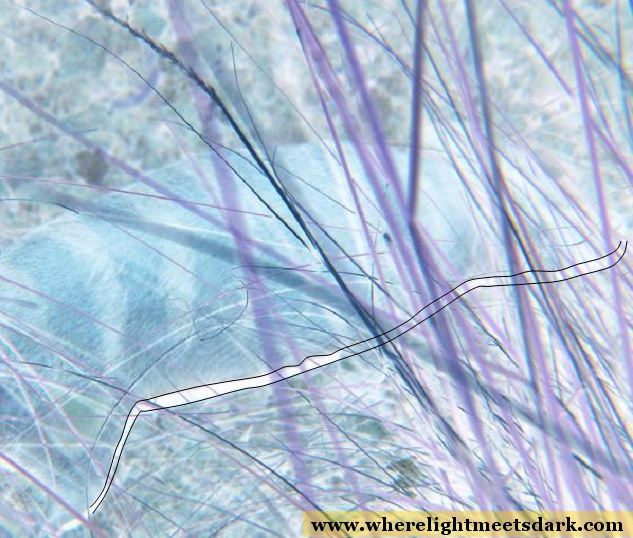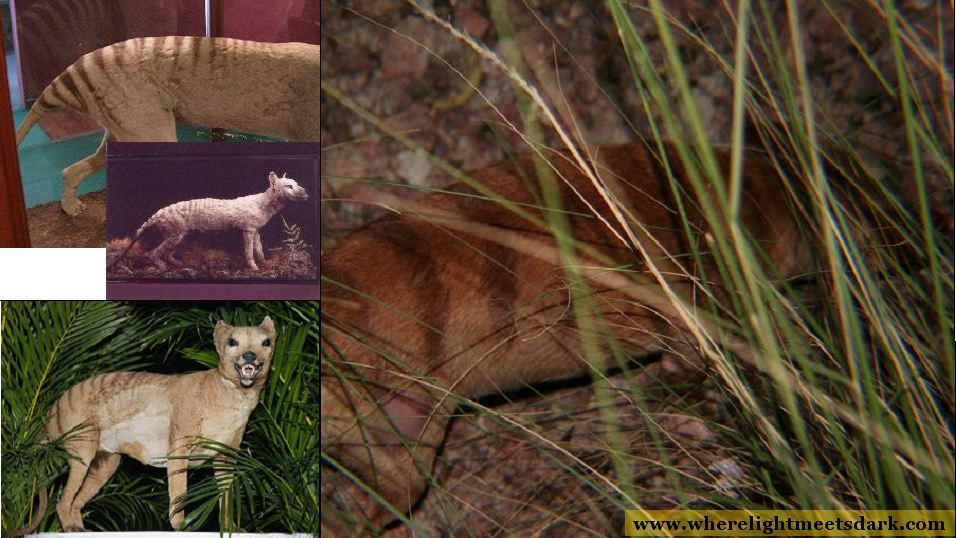Chaotika thylacine - initial analysis
Naming convention
Note (13/10/06): I have dubbed this photo the "Chaotika Thylacine".
Chaotika is the online name used by the person who first published this photograph of a thylacine taken in September 2006 in Tasmania, Australia.
The photographer wished to remain anonymous, therefore, to distinguish this photograph from the Emmerichs photographs, and any subsequent photos, I am referring to it as the "Chaotika" thylacine.
The Chaotika thylacine Another tourist snap of the thylacine in Tasmania? They must be breeding like flies! Once again Cryptomundo has the goods in reporting the story which traces back to a forum posting at The Book of ThoTH.
Let's begin with a look at the photo itself.
Alleged thylacine photo taken in Tasmania, September 2006 (click to enlarge)
OK - when I get an image like this, there are a few things that go through my mind. Firstly, intuition. My gut feel when I first saw this photo was that it looked like a museum specimen in a natural setting. The photo looks real enough, in that it seems to be of a real object, so then how did the photographer get the photo?
The second part of intuition said that the stripes were too widely set apart. This is probably the most common observation in the discussions I have read. Despite this, I make a mental note to check through photos of young thylacines. In my previous analysis of the 2005 Klaus Emmerichs photos I published an image produced by Alton Higgins which compares the striping patterns on a variety of adult thylacines. The results of that analysis were to conclude that stripes appeared to be positioned and spaced fairly consistently along the spine of adult thylacines despite variation in the length and termination of those stripes.
I'll have to come back to the stripe analysis for this present 2006 image later...
Given the initial impression that this may be a museum specimen, it's time to do a quick check of the published images of museum specimen thylacines. Of course, if the photographer visited a museum themselves, then they could create quite a unique image - however, there is a good chance that the same specimen has already been photographed and published.
Analysing the file Unfortunately the EXIF information has been stripped from the available image file. Thus, no particularly useful information is obtainable from the file itself (apart from the image it depicts), although I am in communication with the original publisher of the image to see if better quality versions are available.
Analysing the image Following on from the previous comments about a museum specimen, one of the first obvious features in this image is the pinkish patch which appears at the top of the leg in the lower-left corner of the frame; if this is a museum mount, that feature should make it identifiable.
One commentary suggestion which was made was that the animal resembled a platypus (when the colour levels were adjusted with image editing software). To entertain this notion a little, I played with the colour too.
Adjusted colour levels (click to enlarge)
First up, we have increased the saturation. In this image, you can in fact make out a dark shape at the extreme right of the animal which is correctly positioned for a platypus' bill.
Comparison with platypus (click to enlarge)
Let's take this possibility a little further. In this image I have found a photograph of a platypus (upper right) and rotated it to give it approximately the same orientation as the thylacine image (although facing towards the camera, not away). It is interesting to note the rear foot and to compare it with that region of the thylacine image.
The second platypus photo, in the upper left, seems to my inexperienced eye, to be a little atypical. Nevertheless, it was selected because its orientation best matches the thylacine. Overall, the (very) general body curvature of the thylacine is similar to a platypus - although I'm convinced a comparison with a small spray-painted dog would yield a reasonably similar match.
Lastly, at the right, I have reproduced the "head" portion of the thylacine, blacking out the portion which appears to me to match a platypus' bill. Again the photo is ambiguous, but it is certainly interesting to note that that region is the most consistently dark region in the photo. Although I laughed at the platypus theory at first, this gives me pause to reconsider.
Negative
Next we have a look at the negative, and again the platypus theory comes to mind. Notice the bright white streak running almost horizontally across the lower half of the image; that corresponds to the shadow cast by the animal from the camera flash. Tracing this line to the right of the image we can see that it does, in fact, extend as far as the platypus bill we identified in the previous image. Not only was the dark (bill) portion of the image dark, but it actually had a distinct shadow which is clearly seen in this image.
Negative with overlay
In this image the shadow has been traced as an overlay to illustrate the point made in the previous section. Some portions have been interpolated (Examine the original negative above for a comparison).
Although the rear leg implies more of a canine or even thylacine, the front portion of the animal is difficult to explain as being dog-like. There are no obvious head-like features. Typically an observation like this would be explained by saying the animal has its head turned away from the camera, yet the negative image reveals a definite shadow. By examining the way in which the shadow is formed near the stomach and hind leg of the animal, we can infer how the shadow ought to have been formed at the front of the animal. Given the lack of obvious head-shape, a platypus' bill again best fits the evidence.
The head does not appear to be cropped at right either, as there is no comparable animal-colouration along the right edge of the image.
Additionally, there is no obvious forelimb in either the original image or the negative which otherwise highlights the lower edge of the rest of the visible portions of the animal.
Is it a thylacine? At this point I don't think it's a thylacine - although I haven't yet thoroughly compared it to one.
The missing forelimb and missing head can be explained by substituting a platypus - but then the rear leg is incongruous.
The rear leg, stomach and spine are consistent with a spraypainted dog as much as a thylacine - but then the dog is also missing its head and forelimb.
In addition to these anomalies, the proximity of the animal to the camera is incredibly highly unusual when contrasted with the known behaviour of wild thylacines for avoiding human interaction. This view was also commented on in other forums.
The pink patch on the rear of the leg seems as if it should be significant, but any wild (or even domestic) animal could bear such a wound. Again, on a separate forum suggestion was made that this patch resembles veterinary work conducted on the leg (thus excluding a thylacine).
Widely spaced stripes
After wading through over 300 photos looking for a platypus match, I turn my attention to a similar number of thylacine photos. Of these I found only a handful of photos of museum specimens which had striping anywhere near as widely spaced. To the contrary, stripes are typically quite close together, as demonstrated by Higgins' analysis (see link, above) and as can also be seen in a rug which was made using eight thylacine skins.
Further considerations Beyond the above observations, I feel very little useful information can be obtained from the image at this point which cannot be otherwise explained by a dog or other similar mammal.
At a glance, the stripes seem too widely spaced, too thick and too long at the front of the animal. The head seems to be missing.
Alternatively, perhaps the animal is oriented in the other direction, with the head cropped at left - in which case again the stripes positioned above the forelimb appear too long to be consistent with a thylacine.
There appears also to be non-natural objects on the ground - both in the foreground and in the background - coloured whitish. Whilst the background object appears blurred, and may be insignificant, the foreground object(s) appear to resemble litter in the grass. This would be highly inconsistent with the expected location of a thyalcine sighting.
Conclusion At this stage I feel that there are significant anomalies which are inconsistent with a thylacine. Some may be explained by the lack of information in the image (the head may be cropped to the left, the leg which should appear at right may be obscured by the grass, the "litter" may not be litter), but the striping pattern may not be dismissed so easily.
Although the original story accompanying the image mentioned that a second photo failed to depict any thylacine, I feel that including the second image in the analysis may yield additional useful information. Likewise, if the original images (preferably including EXIF information from the camera) were made available for examination, then again additional useful information may present itself.
I would be happy to continue the analysis with the additional and/or original images, and to discuss them with either the photographer or the publisher. I eagerly await their reply!
